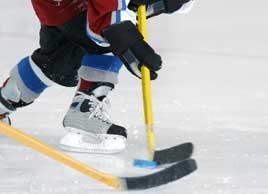Get in shape with women’s hockey
A great cardio workout, hockey also strengthens leg, ab and back muscles’and it’s not just for the boys. Learn about the popularity of women’s hockey and what it can do for you

Source: Best Health Magazine, November/December 2008
Stop by just about any arena on just about any night, and you’ll find women barrelling down the ice, taking shots on goal and having a blast. Women’s recreational hockey is a small but mighty part of Canada’s sports scene. According to Hockey Canada, in 2007-08, nearly 16,000 women over age 18 laced up their hockey skates on a regular basis, and thousands more are registering every year. (More than 60,000 females under 18 play hockey, so those adult numbers are sure to keep on growing.
It’s easy to see why so many women are passionate about the sport. “I love that it’s an all-encompassing activity; everything else falls away when I go to the rink,” says T.A. Loeffler, a professor at the school of human kinetics and recreation at Memorial University in St. John’s, who both plays and studies the game. “It’s all about skating and passing and that delicate interplay of a team sport. And it’s amazing exercise that doesn’t feel at all like exercise!”
Physical payback
Several key components make hockey a great workout. First up is the combination of short intense bursts of activity, with time to recover’players are typically on the ice for a minute, then on the bench for a few minutes, then back on the ice again. “Your heart rate and metabolism stay high the whole hour you’re playing, and probably an additional 15 to 30 minutes after the game is done,” says Michael Bracko, a Calgary sports physiologist and the director of the Institute for Hockey Research. “So you’re burning lots of calories‘about 400 an hour, depending on your age, weight and level of fitness’and strengthening your heart as well.” Skating also strengthens muscles in the legs (specifically the quadriceps, the main muscles in the thighs) and the butt. “As well, your core muscles are engaged almost every moment you’re on the ice, so it’s a pretty good workout for your abs and your back,” Bracko says.
Mental benefits
Many women find that hockey is a vital part of good mental health, too. Loeffler interviewed female recreational hockey players between the ages of 38 and 56’women who grew up being told that hockey is a “boy’s game”’and found that playing Canada’s game often has a profound effect on them. “Women see themselves in new ways through the game,” she says. “They not only have a sense of belonging to a team, they have a connection with their families, if their kids or partners also play or watch hockey, and they have a connection to Canadian culture.” And, she adds, because a lot of different body types can be good at the game, and because the bulky equipment is an equalizer, female hockey players often feel less self-conscious about their body size than they would in the pool or at the gym.
Injury prevention and training
Body checking isn’t allowed in women’s hockey, but it’s still a physical sport that involves lots of body contact with other players (as you try to get possession of the puck), and with the ice and boards. “With female hockey players, we tend to see upper body injuries, particularly the shoulder, because of body contact,” says Bracko. He recommends four exercises on weight machines at the gym to strengthen the upper body: a chest press or bench press, seated cable row, shoulder press and lat pull-down. Because you spend your time on the ice bent forward, it’s important to give your back a break while on the bench by either sitting up straight or leaning back against the bench, rather than leaning forward. Also, since hockey is such a cardio-intensive game, if you’ve been diagnosed with, or are at risk for, heart disease, it’s important to get the all-clear from your cardiologist.
Olympian advice
To protect your heart and improve your game, follow the lead of elite players, who cross-train. “We never get stuck in a rut,” says two-time Olympic gold medal winner Becky Kellar, 33, who plays defence for the National Women’s Team. “We do a lot of cardio, a lot of weight training. In the past, we’ve done some yoga and pool work, and right now a bunch of us are taking a boxing class, which is a good workout and helps you develop ‘quick feet.’ ”
But local beer league or international tournament, some things never change: “It’s always great to be out with the girls,” says Kellar. “Whether you’re out on the ice or joking around in the dressing room afterwards, you create friendships and that’s what makes it so fun.”
Don’t miss out! Sign up for our free weekly newsletters and get nutritious recipes, healthy weight-loss tips, easy ways to stay in shape and all the health news you need, delivered straight to your inbox.




